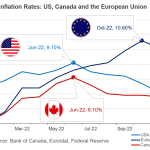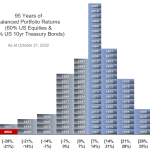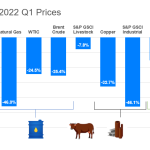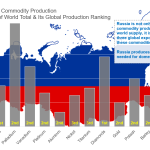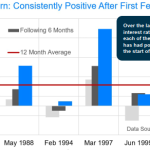If
the embedded document is not visible above, then the text and
charts of the newsletter can be viewed below in html format:
Canada & the USA, a Tale
of Two Economies
Canada
Out-of-Step With the US

When
two countries are as interconnected as Canada and the US, it is often
the case that their respective economic circumstances are at least
somewhat similar. For these two North American neighbors, however,
their economies and stock markets have diverged considerably over
recent months. This shouldn’t come as too much of a surprise, as we had
indicated in our last newsletter that leading economic indicators of
each economy were already signaling a slow down in Canada’s economy and
a much awaited resurgence of the US.
It
is important to point out that stock markets are only a partial
reflection of the overall economy. And despite ebbs between the
performance of Canadian and US economies, historically their two stock
markets have been highly correlated. More recently, however,
a pronounced divergence has emerged with Canadian stock markets
remaining relatively flat over the last year as US stocks marched
higher. This disconnect is illustrated below.
If
one were to search for an explanation for this divergence then the
fundamentals of the Canadian economy and slowing global commodity
prices are a great place to start. One of the biggest reasons for this
underperformance has to do with the makeup of the two countries’
markets. Approximately 40% of the Canadian stock market is made up of
natural resource stocks – more than double the 15% resource exposure of
the S&P 500 (US Stocks).
Canada’s Decade
of Success
For
much of the last decade, rising commodity prices were a strong tailwind
to Canadian equities. The world was knocking on Canada’s door. The
allure of the riches of the Canadian oil sands, robust commodity
consumption from China and an appreciating Canadian dollar made
Canadian equities attractive assets. As this went on, the capital
inflows into Canada from around the world made Canadian equities even
more attractive.
The Energy
Sector
The Canadian energy sector, which comprises over 25% of the
S&P/TSX index, has in large part acted as an anchor on Canadian
equities.
While the price of oil has stayed relatively high, Canadian oil
companies have not been able to benefit as much as their US
counterparts. In fact, for much of 2012, Canadian oil companies were
receiving up to $20/barrel less for oil shipped to the US. This was due
to limited US refinery capacity, pipeline constraints, and rising US
oil production that combined to create a glut of oil.
Profits for the Canadian energy sector declined by more than 50% in
2012, to a little more than $7 billion which is on par with 1999
levels. As the sixth largest oil producing nation in the
world, the discount that Canadian oil companies receive on their crude
production has an economic impact. Estimates indicate losses
due to the discount in pricing to be upwards of $15 billion to $18
billion per year.
This issue will likely continue to confront our oil producers for some
time as pipeline capacity will continue to be constrained even if the
Keystone XL pipeline wins approval later this year from the Obama
Administration. The 830,000 barrel/day pipeline would not start moving
oil until late 2014 at the earliest. The chart below illustrates its
proposed route from Hardisty Alberta to Cushing Oklahoma.

Chart
source: Canadian Association of Petroleum Producers (
www.capp.ca)
As investor confidence has been jarred by the developments in the
Canadian oil sector, it has left many of the largest oil producers in
Canada trading at very cheap valuations – rivalling the levels reached
during the recession. These valuations plus their strong
track records of dividend growth has made them very attractive
investments. After releasing first quarter 2013 earnings, Canadian
energy giants, Suncor and Canadian Natural Resources raised their
dividends by 54% and 21% respectively.
The catalyst to unlock this value and move stock prices higher will
come from the approval of new pipelines that will move Canadian crude
faster to the US Gulf Coast, Eastern Canada and to the Pacific Coast
where Canadian oil companies will be able to access Asian markets. The
access to Asia is especially important as US energy production
continues to rise and China assumes its expected title of world’s
largest oil importer. According to the International Energy Agency, US
production of oil will help to lower US oil imports from 10 million
barrels/day in 2010 to about six million/day by 2035. As of the end of
April 2013, US oil production stands at 7.3 million barrels/day which
is up nearly 20% from a year ago.
Commodities
Sector
Another drag on the Canadian stock market has been the sharp drop in
agricultural and base metal prices. Commodity stocks represent almost
20% of the Canadian stock market while they are less than 1% of the US
S&P 500.
Copper has earned the nickname of “Dr. Copper” for its reputed ability
to call turning points in the economy. Oftentimes, copper prices have
turned higher or lower in anticipation of the economy’s turning points.
Copper prices have fallen by about 5% over the last two years. A large
part of the reason for the decline in copper prices is likely due to
fears about the Chinese economy.
China’s leadership has made a central plank of its policies the
intention to make the Chinese economy less reliant on construction and
capital investment. The excessive reliance on construction and capital
investment has led to fears of a bubble in property and overinvestment
in various industrial sectors. In addition, the European Union is the
second largest consumer of copper and it is mired in recession which
has hindered copper demand further. Offsetting this weakness
is the budding rebound in US construction.
Financial Sector
When
the Great Recession ended in 2009, Canadian banks were trading at a
significant premium to banks in most countries. Gradually, the rise in
the stock prices of US banks has helped to narrow the valuation gap
between Canadian and US banks. In recent quarters, investor fears about
Canadian consumer debt and elevated house prices have made investors
cautious on Canada’s banks. The fear arises from the distinct
possibility that a decline in Canadian real estate will impact banks
through rising mortgage defaults and a made-in-Canada debt-reduction
process.
North American
Economic Landscape
When the Great Recession ended in 2009, one of the most repeated
predictions was that the US savings rate would rise to match the levels
of the 1960s and 1970s. The thought was that consumers had undergone a
generational change in mindset towards spending and saving as a result
of the economic turmoil that had enveloped the global
economy. After a brief rise in the immediate aftermath of the
Great Recession, the personal savings rate in the US has fallen once
again to 2.3%. While this has helped the US economy achieve one of the
best economic growth records amongst the advanced economies, the low
savings rate is a function of poor wage growth. In fact, wages as a
percent of the US economy are at a record low.
Stagnant wage growth has helped to propel US corporate profits and they
are now at a record level as a percentage of the US economy. As Ron
Perelman, the chairman and CEO of Revlon stated recently in an
interview:
“Unfortunately
what is good news for American industry…is bad news for those looking
for work …We’ve rationalized our businesses over the last five years…
those people that we laid off in 2008-2009, there’s no need for us to
hire back … We’ve gotten more efficient and we’ve gotten more
productive.”
– CEO of Revlon
As the current economic recovery has been sub-par by historical
standards, corporations have struggled to maintain revenue growth so
they have been focusing on cost controls to help meet profit
expectations. Corporate profit growth in the US was lower in 2012 than
2011 but the US market has been able to overcome slowing profits
because investors have given the economy the benefit of the doubt. The
Price-to-Earnings (P/E) ratio has risen to about 16 – meaning investors
are willing to pay $16 for each dollar of corporate profits.
This has allowed the market to continue higher as central banks around
the world are going to remain ultra-accommodative and help to ensure
liquidity is well supplied to the markets. Though economic data has
been disappointing in recent weeks, investor confidence is strong and
the demand for equities has been resilient.
